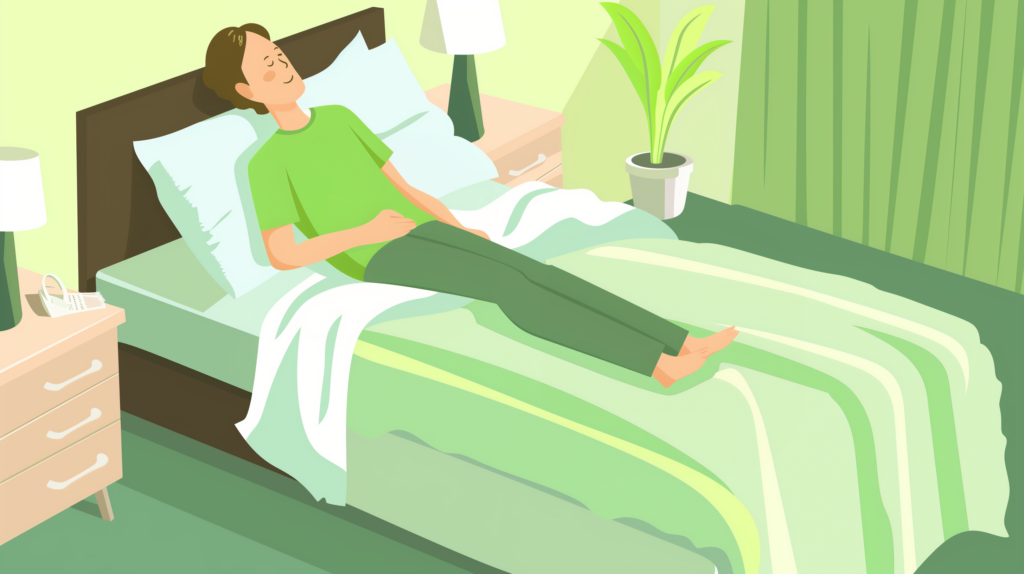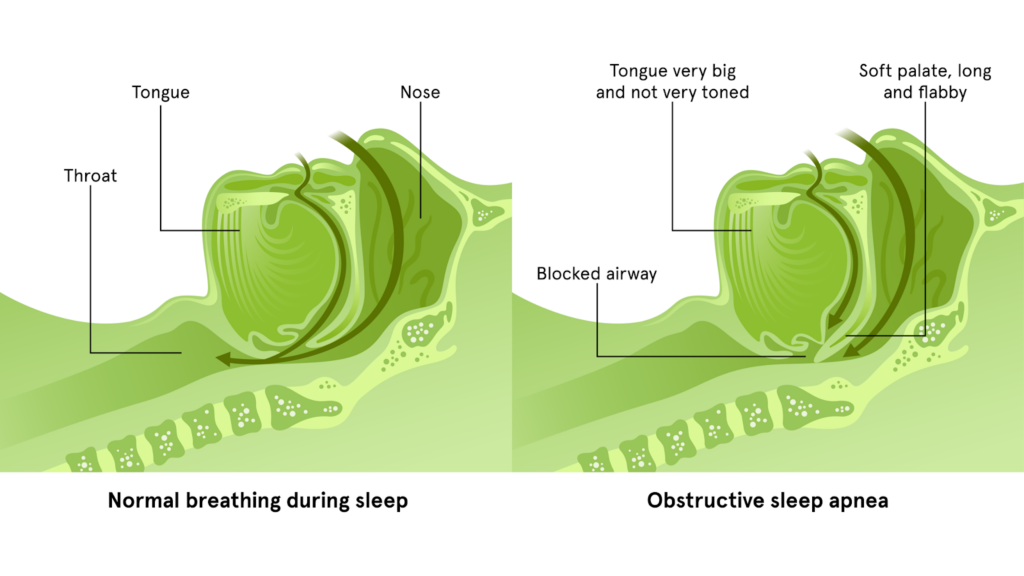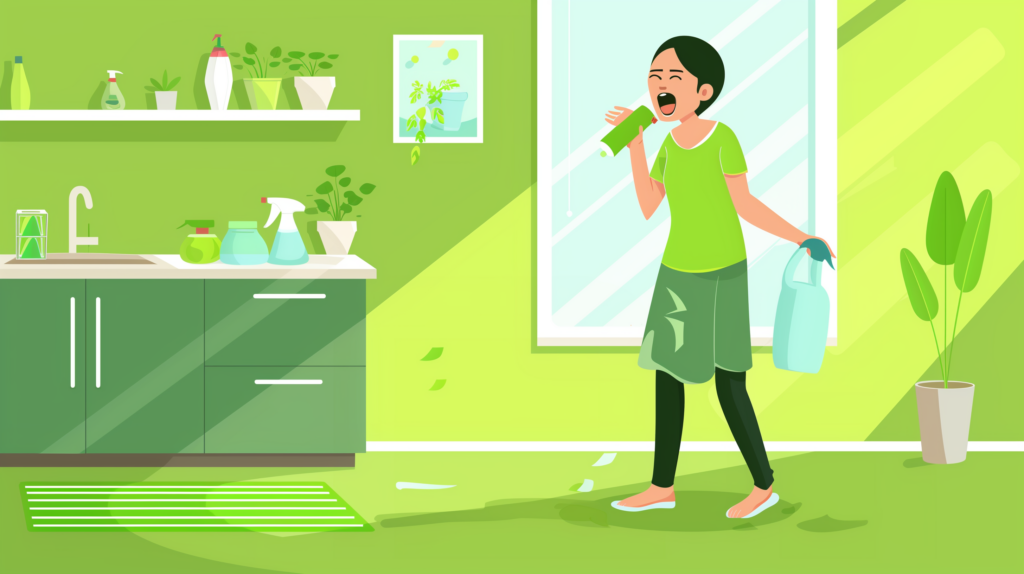While PAP therapy is the gold standard treatment for sleep apnea, and diet and exercise are often recommended, many people aren’t aware that specific exercises you can do with your mouth, face, and throat can also help.
Sleep apnea exercises can be a real game-changer for many. But making the most of them is all about knowing how to do these exercises correctly.
We’re here to guide you through these techniques in simple steps.

Turn those restless nights caused by snoring and sleep apnea into restful, rejuvenating moments that leave you ready to take on the day again.
In this guide, we’ll explore why snoring and sleep apnea happen, discuss exercises to improve your experience, and look at additional measures you can take to amplify the benefits and reclaim your health.
Ready to learn more? Let’s explore how simple exercises can strengthen your airway and improve sleep quality.
Understanding Snoring and Obstructive Sleep Apnea (OSA)
Snoring and sleep apnea can turn quiet nights into noisy ones, disturbing your sleep and those around you.
But what causes these sleep disturbances?
Imagine your throat as a pathway for air to flow through.
When you’re awake, muscles around this pathway keep it wide open. But as you sleep, these muscles relax.
For some people, they relax too much.
This can narrow the pathway, obstructing the flow of air.
These obstructing tissues in your throat vibrate when you breathe, producing the sound we know as snoring.

In more severe cases, the throat muscles relax so much that they block the airway completely. This can cause you to stop breathing for short periods while sleeping and is called obstructive sleep apnea (OSA).
Once your body realizes you’ve stopped breathing, it immediately wakes you up slightly to reopen the airway, disrupting your sleep even if you don’t remember it in the morning.
Several factors can increase the risk of snoring and sleep apnea, including:
- Alcohol consumption: Drinking alcohol can relax throat muscles more than usual.
- Excess weight: Extra tissue around the neck can squeeze the airway, narrowing it.
- Certain medications: Some medicines can increase muscle relaxation during sleep.
- Sleeping position: Sleeping on your back can cause your tongue and soft tissues to drop, narrowing the airway.
But there’s good news! You can do exercises to strengthen the muscles in your throat, reduce snoring, and improve sleep apnea symptoms.
These simple yet effective exercises can significantly affect sleep quality and overall health.
Sleep Apnea Exercises: Simple Techniques for Better Sleep
Before we outline the exercises, we want to be clear that we’re not medical professionals. This is not medical advice.
If you have any doubts or questions about the suitability of the exercises outlined below, please consult your family physician or sleep specialist.

You might also consider seeking out a myofunctional therapy specialist, as many of these exercises are lighter versions of standard techniques they employ
These exercises are also not a substitute for PAP therapy and more intensive medical interventions.
If you’re struggling with snoring or mild obstructive sleep apnea, incorporating specific exercises into your daily routine can make a big difference.
These four exercises are designed to strengthen the muscles around your airway, keeping it open and reducing snoring.
1. Tongue Slide
Start by placing the tip of your tongue against the back of your top front teeth. Slowly slide your tongue backward along the roof of your mouth as far as it can go without causing discomfort.
Try to do this exercise in sets of 10, two or three times a day for the best results.
This exercise targets the muscles at the base of your tongue, helping to prevent them from relaxing too much during sleep.
2. Tongue Press
Suck your tongue upward against your palate, pressing your entire tongue against your palate before relaxing and allowing your tongue to return to a normal position.
Do this exercise in sets of 10 twice a day.
3. Jaw Stretch
Open your mouth as wide as possible without causing pain, then slowly close it. Ensure your movements are controlled and smooth.
Try to do these in sets of ten twice a day.
This exercise works on your jaw’s flexibility and strength, which can help reduce the symptoms associated with sleep apnea.
4. Breathing Through Your Nose
Practicing nasal breathing during the day can help you maintain it during sleep.
It’s about keeping your mouth closed and breathing through your nose, which can improve airflow and reduce snoring.
5. Pronouncing Vowel Sounds
Loudly say the vowels of the alphabet—A, E, I, O, U—for three minutes daily. You can break this up throughout the day.
While it might feel a little silly, this exercise strengthens the muscles in your throat, which can help keep your airway open during sleep.
6. Singing as an Exercise
Singing for at least 20 minutes a day can also be beneficial.

It works various muscles in your throat, reducing snoring and improving sleep apnea symptoms.
Remember That Consistency Is Key
To see significant benefits from these exercises, consistency is crucial.
Aim to practice them daily for several months. If you struggle to keep up with them, consider making them a part of your morning or bedtime routines, or make a point to add at least one to your daily lunch break.
Embracing a Holistic Approach to Sleep Apnea Management
Beyond these airway, tongue, and throat muscle strengthening exercises, embracing a holistic approach to managing sleep apnea can include lifestyle changes, such as maintaining a healthy weight, reducing alcohol consumption, and adjusting your sleep position.
Combined with regular practice of the exercises we’ve discussed, these changes can provide a solid foundation for better sleep.
However, it’s important to recognize when additional support is needed.
For many, CPAP therapy is crucial to managing sleep apnea effectively.
CPAP machines work by keeping your airway open while you sleep, preventing interruptions in breathing that lead to poor sleep quality and health risks.
If you or someone you love struggles with sleep apnea symptoms, consult your primary care provider or a sleep specialist.
Obtaining a sleep study is easier nowadays thanks to at-home options (where available), and CPAP machines and accessories are more customizable than ever.
This makes the benefits of PAP therapy more accessible than ever and, perhaps more importantly, makes it easier to acclimate to the new sensations and routines typically involved.
FAQs Related to Sleep Apnea Exercises
How long does it take to see results from sleep apnea exercises?
The time it takes to see results from sleep apnea exercises can vary from person to person, but most experts recommend practicing the exercises consistently for several months to see significant improvements in snoring and sleep apnea symptoms.
The exercises are designed to strengthen the muscles around the airway, which takes time and dedication.
Can these exercises replace CPAP therapy for sleep apnea?
Sleep apnea exercises are not a replacement for CPAP (Continuous Positive Airway Pressure) therapy, considered the gold standard treatment for moderate to severe sleep apnea.
While exercises can be helpful for some individuals with mild sleep apnea or snoring, they are not a substitute for the medical treatment recommended by sleep specialists.
Are there any risks or side effects associated with these sleep apnea exercises?
The sleep apnea exercises are generally considered safe when performed correctly.
However, it’s always a good idea to consult with a healthcare professional, such as a sleep specialist or a myofunctional therapist, before starting any new exercise routine, especially if you have any underlying medical conditions or concerns.
Can these exercises help with sleep apnea in children?
While some of the sleep apnea exercises, such as tongue and jaw exercises, may also benefit children, the specific needs and treatment approaches for pediatric sleep apnea can differ from those for adults.

Consult with a pediatric sleep specialist to determine the most appropriate treatment plan, which may include a combination of exercises, lifestyle changes, and medical interventions.
Final Thoughts
As Canada’s leading online store for CPAP supplies, we’re dedicated to helping you find the right solutions for your sleep apnea treatment.
If you’re looking for affordable options to supplement your sleep apnea exercise routines, we offer a wide selection of the latest CPAP equipment and accessories at unbeatable prices, ensuring access to the best products to support your journey to better sleep.
Our commitment to customer satisfaction means you can count on us for expert advice and support every step of the way.
Don’t let sleep apnea control your life. You can enjoy restful nights and energetic days with the right exercises, lifestyle changes, and CPAP therapy.
Remember, you’re not alone in this journey. Contact us today.
References:
- Sleep Care Online: Exercises to Reduce Sleep Apnea
- Sleep Foundation: Mouth And Throat Exercises to Help Stop Snoring and Improve OSA
- SleepApnea: Mouth Exercises to Stop Snoring
- Florida Sinus and Snoring: 14 Convenient Exercises To Improve Chronic Snoring And Sleep Apnea
- Sound Sleep: Exercises to Help Obstructive Sleep Apnea

